blake mclimans
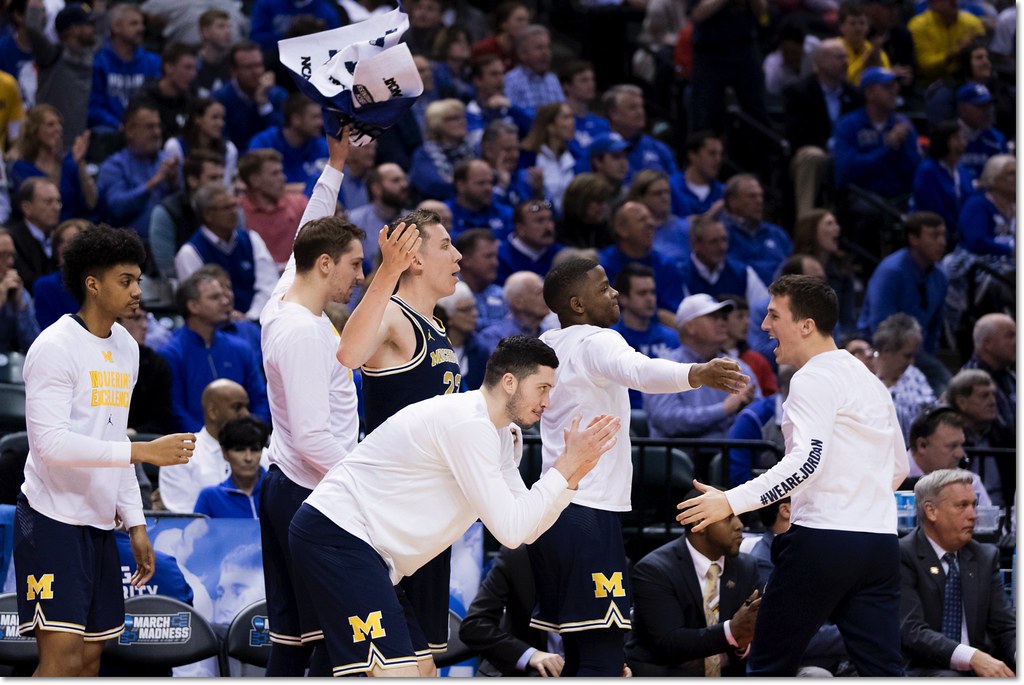 In fine form. [Marc-Gregor Campredon]
In fine form. [Marc-Gregor Campredon]
Previously: All-Bench
John Beilein has spent ten seasons in Ann Arbor. As of the most recent, he's the winningest coach in program history with 215. He snapped Michigan's post-sanction tournament drought in 2009, the first of seven NCAA appearances with the Wolverines, three of which have extended at least into the second weekend.
In recognition of the above, as well as the need for offseason #content, I've put together a series of All-Beilein teams, inspired by this twitter post and the ensuing conversation. My guidelines:
- I'm attempting to put together the best possible lineups, which isn't necessarily the same as picking the best individual players at each spot.
- I'm choosing individual player vintages (i.e. 2013 Trey Burke). A player can only be chosen once for each category, but different player years (i.e. freshman bench gunner 2014 Zak Irvin and well-rounded senior 2017 Zak Irvin) can be eligible for separate categories. The same player/year can be chosen for multiple categories—for instance, 2013 Mitch McGary making the All-Bench team doesn't exclude him from making the final All-Beilein team.
- Eligibility for certain categories may be slightly fudged because of the limited pool of players.
I'm not putting too many constraints on myself for this exercise since the point is to let our imaginations run wild. Speaking of running wild, this team is a little different than the others: today's group is comprised of the best contributors to the Bench Mob.
RINGLEADER: 2013-14 ANDREW DAKICH
The only member of the Bench Mob to merit his own highlight video. Dakich peaked in this role in 2013-14, when he could be the exuberant youngster instead of an assistant coach in the making. He's the ideal captain of a Bench Mob: he'll dance in the pregame huddle, be the first off the bench to greet players after a timeout, make a scene after a big shot, and coach up the point guards on the best way to approach the high ball screen. It won't be easy to fill (and leap out of) his seat.
Honorable Mention: 2012-13 Josh Bartelstein. Another walk-on who became a team leader, Bartelstein isn't your traditional hyper-excited bench fixture. Anyone with ESP, however, deserves serious consideration for the first team.
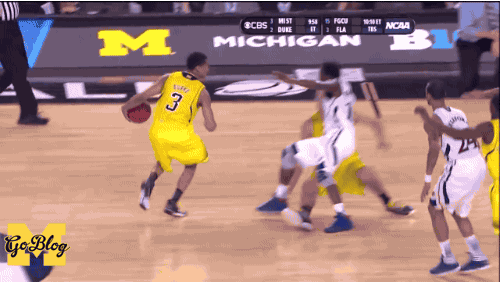
If we were ranking legendary Bench Mob moments, this would be at the top.
[Hit THE JUMP.]
Previously: Early Outlook, The Rotation Part I
Basketball season starts in nine days, which is wonderful news until I realize how far behind I am in the basketball preview (I'm beginning to understand how Brian feels in August, just on a far smaller scale). So far, we've covered the guards/wings; today, it's time to look at the bigs, plus freshman Glenn Robinson III, who will likely play both the three and the four.
Fans of Michigan basketball may be shocked to hear this after the last, oh, decade-plus, but the Wolverines have a little something called 'depth' in the frontcourt this year. While the loss of Zack Novak leaves a hole in the leadership/grit/shooting department and the transfer of Evan Smotrycz hurts depth and shooting, the two highest-touted of Michigan's highly-touted freshman class can replace those minutes at the four. Jordan Morgan returns in the middle. Jon Horford is back from a foot injury that kept him out for most of last season. That's a legitimate four-man rotation up front, and guys like Blake McLimans and even Matt Vogrich—as the Zack Novak Memorial Hilariously Undersized Power Forward—could get minutes up front as well.
Without further ado, your returners, departures, and newcomers:
Returners: PF/C Jordan Morgan, PF/C Jon Horford, PF Blake McLimans, PF Max Bielfeldt
Departures: PF(!) Zack Novak (graduation), PF Evan Smotrycz (transfer)
Newcomers: PF/C Mitch McGary, SF/PF Glenn Robinson III
[Hit THE JUMP for the full breakdown]

From our very own Zack Novak photoshop thread.
This is part two of the hoops season recap; part one, covering the guards, can be found here.
It should not come as a surprise to those who have followed John Beilein's Michigan squads that a post covering the team's "bigs" would feature a photo of 6'4" Zack Novak at the top of the post. Michigan entered the season relatively thin in the frontcourt, and things only got worse when backup center Jon Horford suffered a stress fracture in his right foot in December, an injury that would ultimately sideline him for the remainder of the season. When Evan Smotrycz suffered through a brutal slump to start conference play, Novak found himself starting at power forward, reprising his role from years past instead of playing his natural two-guard position.
While Michigan got solid seasons out of Novak and Jordan Morgan, along with some inspired efforts from Smotrycz, the lack of size up front was the team's greatest weakness. This was exposed each time Michigan played Ohio State or Michigan State, especially away from Crisler, and even when all of the bigs got in foul trouble at Northwestern and Colton Christian played important minutes at center. This shouldn't be as much of an issue next season with the addition of Mitch McGary and the return of Horford, but Smotrycz's departure hurts. Let's look back on each player's individual contributions:
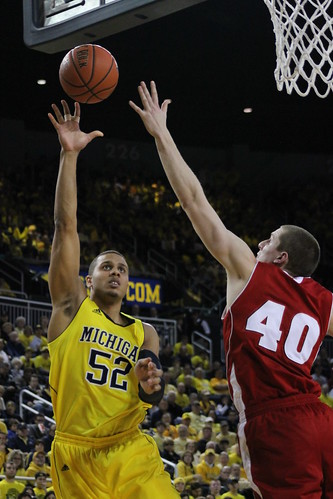 Jordan Morgan
Jordan Morgan
Preseason Expectations: Morgan entered the season as the returning starter after a surprising redshirt freshman season, but he still had to hold off Jon Horford to keep the job. The hope was that he'd develop his post game while continuing to play solid defense, rebound, and hit his fair share of high-percentage shots.
Postseason Reality: Morgan still hasn't displayed much in the way of a back-to-the-basket game, and he missed a maddeningly large amount of layups. The latter point was a source of great frustration, along with his propensity for early foul trouble, but overall Morgan was quite solid in the middle. His defense improved—including a sharp decline in foul rate—his rebounding was solid, and he shot just a hair under 62% from the field. Trey Burke didn't look to Morgan as much as Darius Morris did last year, and there was a clear adjustment period while he got used to playing with a different style of point guard. While there wasn't a big leap forward in Morgan's offensive game, as many had hoped, he did not regress, either. Meanwhile, he was in better shape, running the floor well and consistently posting strong defensive performances. Morgan probably isn't ever going to be an offensive force, nor a intimidating shot-blocker—the touch and explosive athleticism just aren't there—but he's a solid presence who should end up as a four-year starter.
Highlight: The Ohio State win was the most memorable of the season, and it was also the best game of Morgan's career, as he posted his first double-double—11 points (5-8 from the field) and 11 rebounds—while limiting Jared Sullinger to 14 points on 6-14 shooting. Morgan also beat Sullinger down the court for a pair of thunderous dunks in transition.
Lowlight: When Michigan matched up against Ohio State in the conference tournament, things didn't go so well. The Buckeyes dominated the Wolverines inside, and Morgan could only muster three points (1-5 shooting) and four rebounds while turning the ball over three times.
Key Numbers: 61.9 2pt%, 17.8 DR%, 3.9 fouls committed/40 minutes
Next year: Morgan should start at center once again, and it would be nice to see him break out a go-to post move. Mostly, however, Michigan will need him as a rebounder/defender/screen-setter, which falls right into his comfort zone. Also, make layups, please.
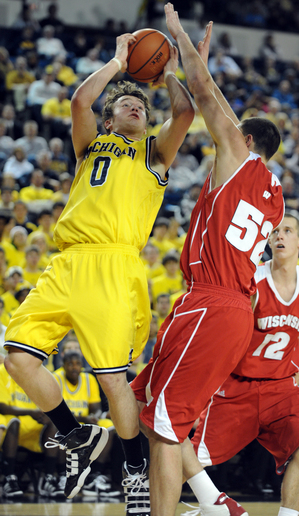 Zack Novak
Zack Novak
Preseason Expectations: Novak was expected to make a grand return to shooting guard, where the hope was that is offensive production would rise now that he no longer had to guard players a half-foot taller while shouldering a large part of the rebounding load.
Postseason Reality: Novak, of course, had to slide back to power forward when Smotrycz was benched early in Big Ten play, and for the fourth straight year his play improved despite not being the focal point of the team. He shot very well from the field—56% on twos, 41% on threes—and posted the team's best ORtg—his 123.3 mark was 39th in the country. Then, of course, you get Novak's trademark grit, as he still marveled with his ability to rebound among the trees while providing solid defense against players who theoretically should be dunking all over him (sometimes they did, but that happens when you're a 6'4" post player). Novak finished his career as the consummate role player, knocking down threes, hitting big shots when called upon, and otherwise doing everything to raise the level of play from his teammates. Michigan fans may not miss having a natural shooting guard at power forward when the 2012 reinforcements arrive, but they'll sure miss Zack Novak.
Highlight: Novak absolutely tore up UCLA back in November, scoring 22 points on eight shots from the field and chipping in three rebounds.
Lowlight: The final game in Novak's Wolverine career was sadly forgettable, as he could only muster a season-low two points on 1-5 shooting and didn't record a defensive rebound in Michigan's tourney loss to Ohio.
Next Year: Novak will take his grit to Europe. Godspeed, captain.
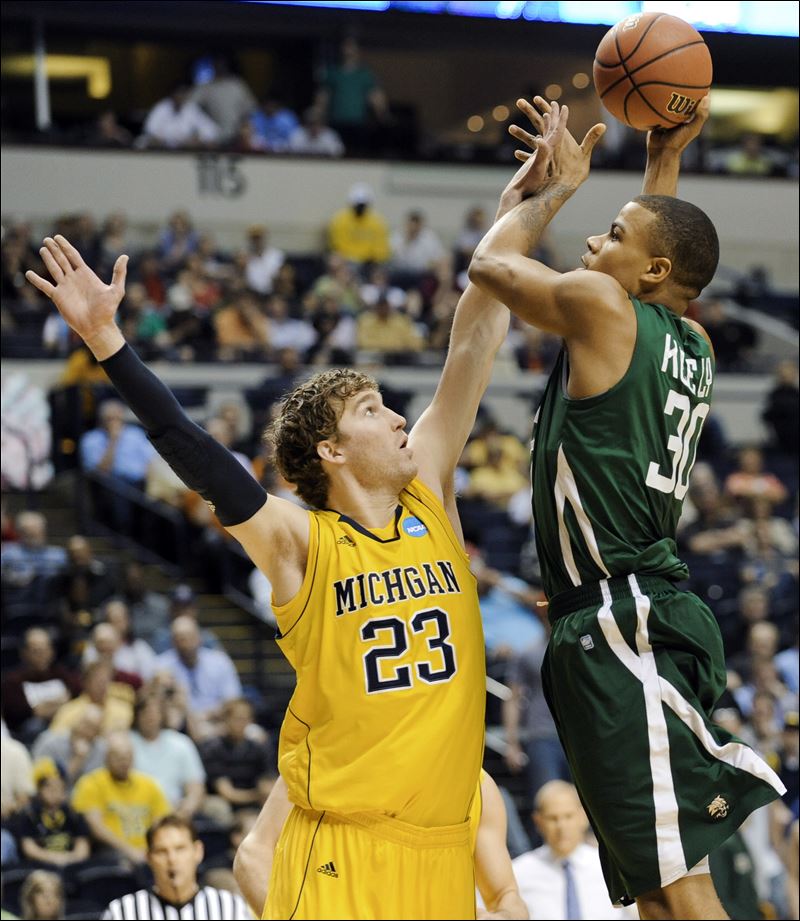 Evan Smotrycz
Evan Smotrycz
Preseason Expectations: Smotrycz was pinned as the X-factor for Michigan, a player who could put the team over the top as a sharp-shooting starter at power forward. After a solid but inconsistent showing as a freshman, he looked due for a breakout season.
Postseason Reality: It was a rollercoaster season for Smotrycz, who struggled early, caught fire at the end of nonconference play, then went into a prolonged slump that saw him lose his starting job for the rest of the season. The surprising post-season transfer fits that narrative all too well. The overall numbers are solid: Smotrycz averaged 7.7 points per game with a 58.9 eFG%, and he was also the team's most effective defensive rebounder, bringing in 21.4% of opponent misses when he was on the floor. However, Smotrycz never quite found his game again after losing his shooting stroke in Big Ten play, and his overall defense left much to be desired; he finished with a sky-high 5.8 fouls per 40 minutes as he played defense with his hands instead of his feet far too often. Smotrycz on average was an effective offensive weapon, but the inconsistency and defensive shortcomings proved too great to justify giving him starter's minutes.
Highlight: Prospects looked good when Smotrycz scored 20 points on eight shots (4-5 from three) and grabbed nine rebounds against Oakland. It's also worth noting that Smotrycz's 15 points on 6-7 shooting was really the only thing keeping Michigan close against Ohio in the last game of the season.
Lowlight: Smotrycz's final start was the debacle at Iowa, and he failed to score in 22 minutes of play while also committing two turnovers. That was the final straw, as Beilein inserted Stu Douglass into the starting lineup against State.
Key Numbers: 58.9 eFG%, 21.4 DR%, 5.8 FC/40
Next Year: Smotrycz won't be here, which really sucks. Best of luck to him.
Jon Horford
Preseason Expectations: Fight for the starting center job with Morgan, provide at least 15 quality minutes per game.
Postseason Reality: Horford's balky foot robbed Michigan of any depth at center and prematurely ended what was at times a promising sophomore campaign. He showed up much bigger than he was as a freshman, looking the part of a Big Ten center, and he was very active on the glass and as a shot-blocker. Horford doesn't have a polished offensive game, but he brings a lot of energy and is a more athletic option than Morgan, at least when it comes to quick-twitch explosiveness. Much is still unknown, however, as Horford only appeared in nine games.
Highlight: Horford hit all five of his shots from the field, grabbed seven rebounds, and blocked three shots against UCLA, by far the best performance of his young career.
Lowlight: The stress fracture that erased the season's last 25 games.
Next Year: Horford probably won't surpass Morgan at this point, but he should be a valuable backup who won't be much of a dropoff defensively or on the glass. I really like Horford's athleticism and potential, and we'll see how he develops once he gets through rehab and can go full-steam again.
Blake McLimans
Preseason Expectations: McLimans came to the team with the reputation of being the type of sharpshooting big man that Beilein loves, but he couldn't hit the broad side of a barn as a freshman. Expectations were rather low, with the hope being that he wouldn't really need to see the court behind a big man rotation of Morgan, Horford, and Smotrycz.
Postseason Reality: McLimans still isn't much of an inside presence, especially defensively, but he did manage to knock down a decent portion of his jumpers, going 5-12 from beyond the arc and 10-21 overall this season. McLimans only played more than eight minutes in a game once during conference play—the aforementioned Northwestern game—and only was used when both Morgan and Smotrycz got into early foul trouble.
Next Year: McLimans may see his role further decrease when Horford returns and Mitch McGary hits campus. He could see some time as a situational shooter, but he's going to need to really improve on defense if he wants to carve out a larger role.
Colton Christian
Preseason Expectations: Provide the occasional boost of energy off the bench.
Postseason Reality: Christian played a total of 51 minutes on the year, grabbing six rebounds and hitting a few very unexpected shots. Still didn't display much of an offensive game, and was mostly content to hit the class and save his energy for defense.
Next Year: He won't be here, having also put in his name for a transfer. It's highly unlikely he would have seen the floor.
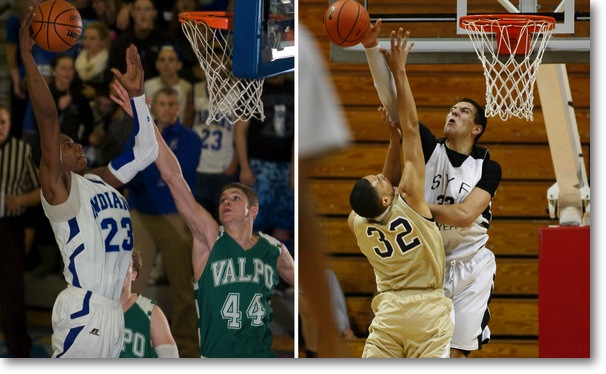
14